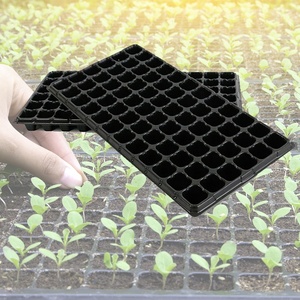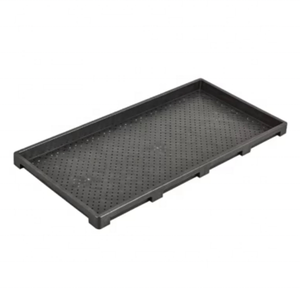(101714 products available)





























































































































































































































































A plant tray is a tool for gardening, which is a flat, shallow container used to hold pots, plants, soil, and water. It helps in the efficient watering of plants and prevents water from spilling on the floor. There are different kinds of plant trays in the market.
Standard Flats
The dimensions of a standard flat are 28 by 54 inches. They are the most commonly used plant trays. With their large size, they are ideal for commercial nurseries and gardeners with big yards.
Cell Flats
These plant trays have individual cells or compartments for starting plants. The cells vary in size from 1 inch to 4 inches. The cell flats are suitable for seedlings and transplants. They make it easy to separate plants without disturbing their roots.
Potted Plant Trays
Potted plant trays are large enough to hold potted plants. They come in different diameters and are suitable for indoor and outdoor use. They provide a clean way to manage water and soil debris from potted plants.
Seedling Flats
These are small plant trays for starting seeds indoors before transferring them outside. Seedling flats have smooth, shallow bottoms without cells. They allow gardeners to spread seeds and cover them with a suitable amount of soil.
Specialty Flats
These plant trays are designed for specific applications. For example, some trays are made for holding hanging baskets, and others are designed for displaying patio pots. Specialty flats offer the right fit for unique planting needs.
Disposable Trays
These plant trays are made from flimsy materials like styrofoam or plastic. They are inexpensive and made for single use. They are commonly found in supermarkets and garden centers. They are convenient for transporting plants and disposing of after use.
Reusable Plant Trays
Unlike disposable trays, these are made from sturdy materials. They are designed for multiple uses and can be washed and reused for many planting seasons. They are eco-friendly and cost-effective over time.
Self-Watering Trays
These are advanced plant trays with built-in water reservoirs and wick systems. They provide consistent moisture to plants without overwatering. Self-watering trays are excellent for busy gardeners and delicate plants that need steady water.
Modular Trays
Modular trays are designed to fit into specific growing systems or stands. They often have uniform sizes and shapes, allowing for easy stacking, transportation, and integration into existing setups. This modularity is particularly advantageous for commercial growers with large-scale operations.
Customizable Trays
Customizable plant trays offer adjustable partitions or inserts that can be modified to accommodate different plant species or sizes. These trays provide the flexibility needed for mixed cropping or when growers want to change what they're cultivating without investing in new trays.
Seedling Trays with Cell Inserts
Cell insert trays are specialized for starting seedlings. They have multiple cells, each designed for one seedling. This design keeps young plants separate, reducing competition for space and resources. Cell insert trays are great for nurseries and gardeners who want to grow plants from seeds.
Drainage Trays
Trays with drainage holes or slots at the bottom are essential for preventing overwatering and root rot. These trays allow excess water to escape, ensuring healthy plant development. They're particularly crucial for hydroponic systems and any growing method where water management is key.
Stackable Trays
Stackable plant trays are space-saving and convenient for storage and transportation. Their interlocking or nesting designs make them easy to stack when not in use, reducing the storage footprint for growers.
Specialized Trays
Some plant tray designs are tailored for particular plants or growing methods. For instance, orchid trays have larger openings to accommodate orchid roots, while hydroponic trays are made for soilless farming systems. These specialized trays guarantee that certain plants get the unique features they need to thrive.
Seed starting
For those who like to grow their plants from seeds, clear plant trays are a must. The tiny cells give seeds a cozy home to sprout. Plus, these trays often come with lids to keep in warmth and moisture, acting like a protective greenhouse until the seedlings are big enough to move outside.
Transplanting
When seedlings grow too big for their trays, it's time to re-pot. Growers often use larger pots or outdoor gardens to give transplanted seedlings more space to spread their roots. This process helps prevent overcrowding and keeps plants healthy.
Storage
Plant trays are great for storing plants, too. Whether it's houseplants or young veggies, these trays hold pots neatly. Their stackable design saves room, while the sturdy build protects pots from bumps. Growers can keep plants safe in trays until they're ready to move them outside or elsewhere.
Transport
For mobile gardeners, plant trays make transporting potted plants a breeze. The secure fit of pots in the trays prevents shifting during car rides or walks. This means no more messy soil spills or damaged plants. With a sturdy plant tray, taking plants on the go is simple and stress-free.
Hydroponics
For those using hydroponics, plant trays are an important piece of the setup. These soilless systems grow plants in water, and trays often hold net pots or other hydroponic containers. Using plant trays in hydroponic setups keeps everything organized and makes it easy to manage nutrient-rich water for healthy plant growth.
Size
It's important to consider the size of the plants when selecting a plant tray. The plant tray should be big enough to hold all the pots and allow for some extra space. It should accommodate the pots without overcrowding and provide some space for air circulation and watering. The tray should also be deep enough to contain excess water and prevent it from spilling over.
Material
Plant trays come in different materials, such as plastic, metal, or ceramic. Each material has its advantages and disadvantages. For example, plastic trays are lightweight and inexpensive but can become brittle and crack in extreme temperatures. Metal trays are durable and rust-resistant but can conduct heat and affect the soil temperature. Ceramic trays are attractive and retain moisture well but are fragile and costly. The choice of material depends on the user's budget, preference, and location.
Drainage
Many planters are designed with drainage holes to allow excess water to escape and keep the soil from becoming waterlogged. Some planters have slotted bottoms that let water flow through and keep plants healthy. Select a plant tray with good drainage to prevent overwatering and root rot. If the plant tray doesn't have drainage, consider adding some gravel or pebbles to the bottom to create a drainage layer.
Aesthetics
The aesthetic of the plant tray can also influence the overall look of the gardening display. Choose a plant tray that complements the style and theme of the user's garden or home. Consider the color, shape, and design of the plant tray. The plant tray should match the pots and the user's decor. It can be a decorative addition to the gardening display.
Q1: Can users start seeds directly in the plant trays?
A1: Yes, many seed trays are designed for direct seeding. However, ensure that the cell size is appropriate for the seeds being planted.
Q2: How can users prevent the spread of diseases in their plant trays?
A2: Clean the trays regularly and consider using biodegradable trays that break down and prevent disease spread.
Q3: Can users recycle their plastic seed trays?
A3: Check local recycling guidelines for information on recycling seed trays. Some manufacturers also offer take-back programs for recycling.
Q4: How can users train their plants to grow vertically in their plant trays?
A4: Use stakes, trellises, or strings to support plants vertically. Gently tie the plants to the supports with plant ties or clips.
Q5: Can users use liquid fertilizers in their plant trays?
A5: Yes, liquid fertilizers can be applied through the watering system. Dilute them according to the manufacturer's instructions.